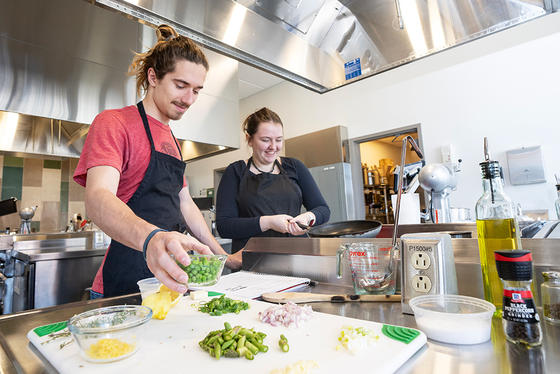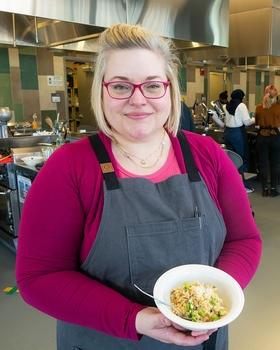The aroma of garlic and onions hits instantly as you walk into the classroom. Five pairs of students shuffle around their assigned stovetop—one in the pair looking intently at a sheet of paper and spouting directions while the other handles the pan of sizzling ingredients.

As they work, Mason chemistry and biochemistry Professor Rebecca Jones moves from station to station to check in on each group. She created the recipe for the risotto they are all cooking for lab and wants to be sure the students not only think through the steps, but also pay close attention to what is chemically happening to each ingredient.
Chemistry in the Kitchen (CHEM 460) is a new course that uses everyday recipes to demonstrate chemical concepts. After the idea came to Jones a year ago, she developed the course and worked closely with the Department of Nutrition and Food Studies to secure the Nutrition Kitchen in Peterson Hall for the lab component.
“Every kitchen is a lab when you think about it,” said Jones. “This class is designed to help students learn what molecules and chemical changes are associated with the food they’re eating.”
The class session covering molecular extraction was quickly followed by a lab with students using ingredients to make pour-over coffee to tangibly see this chemical concept take place as the hot water poured onto coffee beans created a brown liquid.

“The cooking experiments really reinforce your understanding of the topics you learn in class,” said biology major Wilson Plummer. “You’ll touch on a topic, and then get to see it in action.”
Plummer said he liked the interactive nature of the class most, learning about caramelization one day, and making caramels the next, or listening to information on starch hydration and then baking bread.
While students partake in their lab assignment, they routinely take out their phones to capture images of the recipe’s current state from several angles. Instead of the traditional lab report, Jones requires the student to publish a blog post that incorporates photos throughout the cooking process so classmates see differences between their food and comment on each other’s work.
“Sometimes everyone does a slightly different thing while cooking, so they can benefit from seeing those differences in photos,” Jones said.
Students also design and execute their own food experiment, and they did not hold back on creativity. One student tested how sugar interacted with different gelling agents to make the best gummy bears; another measured fermentation’s effect on homemade hot sauces.
Juliana Primavera, a senior chemistry major, said the class combined her love for both cooking and chemistry and that she didn’t want to pass on an opportunity to learn from Jones. “Chemistry majors welcome such opportunities to be creative in our classes,” she says. “The cooking element not only gives us the hands-on experience that allows us to truly understand what's going on, [but] it also makes it engaging, memorable, and fun.”
Inspired by a lab where they made caramel sauce earlier in the semester, Plummer decided to focus his final experiment on soft caramels—more specifically how fat (e.g., dairy milk vs coconut milk) impacts the crystal structure of caramel.
After a few weeks of experimentation, students presented their findings to the class and showcased their work at a public poster session in May.
Primavera’s final project will focus on the effect of varying lye concentrations on pretzel texture. “I wanted to find a recipe that I knew I would use continually, would be complicated chemically, and because I love soft pretzels so much, I figured it would be a perfect learning opportunity.”
Related News
- December 3, 2025
- November 19, 2025
- November 13, 2025
- October 30, 2025
- July 18, 2025
